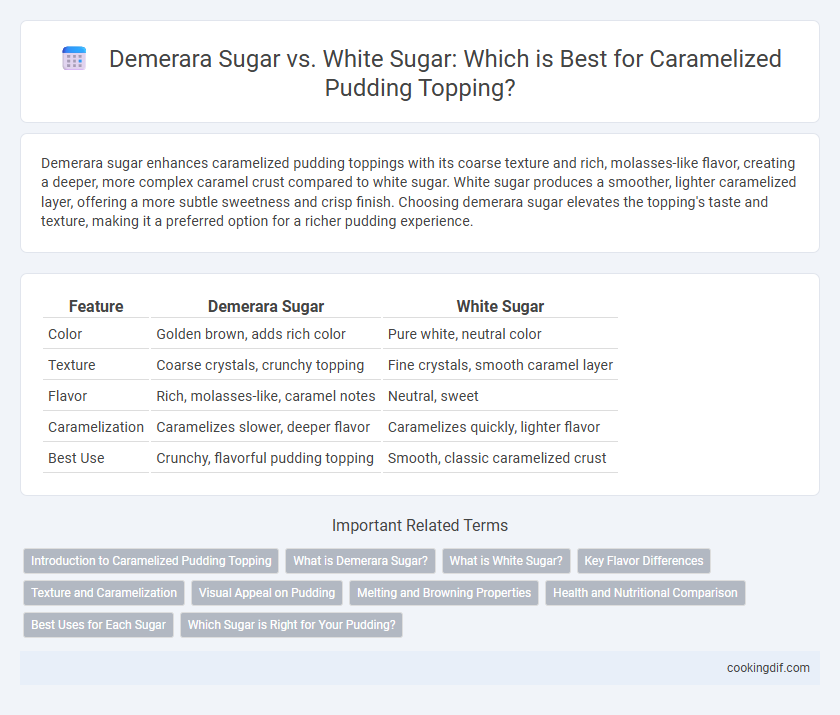Demerara sugar enhances caramelized pudding toppings with its coarse texture and rich, molasses-like flavor, creating a deeper, more complex caramel crust compared to white sugar. White sugar produces a smoother, lighter caramelized layer, offering a more subtle sweetness and crisp finish. Choosing demerara sugar elevates the topping's taste and texture, making it a preferred option for a richer pudding experience.
Table of Comparison
| Feature | Demerara Sugar | White Sugar |
|---|---|---|
| Color | Golden brown, adds rich color | Pure white, neutral color |
| Texture | Coarse crystals, crunchy topping | Fine crystals, smooth caramel layer |
| Flavor | Rich, molasses-like, caramel notes | Neutral, sweet |
| Caramelization | Caramelizes slower, deeper flavor | Caramelizes quickly, lighter flavor |
| Best Use | Crunchy, flavorful pudding topping | Smooth, classic caramelized crust |
Introduction to Caramelized Pudding Topping
Demerara sugar's large, coarse crystals and natural molasses content enhance caramelized pudding topping with a rich, toffee-like flavor and crunchy texture. White sugar, with its finer grains and pure sweetness, creates a smooth, evenly caramelized layer that melts easily. Choosing demerara sugar adds depth and complexity, while white sugar provides a classic, crisp caramel finish.
What is Demerara Sugar?
Demerara sugar is a minimally processed, coarse cane sugar with large amber crystals, known for its natural molasses content that imparts a rich, caramel-like flavor ideal for caramelized pudding toppings. Unlike white sugar, which is refined and granulated to a fine, pure sucrose form, Demerara sugar retains some of its natural oils and flavor compounds, enhancing the depth and texture of the caramelized crust. This makes Demerara sugar perfect for achieving a crunchy, flavorful topping that complements the creamy pudding beneath.
What is White Sugar?
White sugar, also known as granulated sugar, is a refined sweetener derived from sugar cane or sugar beets, processed to remove molasses and impurities for a pure, crystalline texture. It dissolves easily and provides a clean, sweet flavor essential for caramelized pudding toppings that require even melting and browning. Unlike demerara sugar, white sugar caramelizes quickly to form a smooth, crisp topping without the coarse texture or molasses notes.
Key Flavor Differences
Demerara sugar offers a rich, molasses-like flavor and a coarse texture that creates a deeply caramelized, slightly crunchy pudding topping, enhancing complexity with subtle toffee notes. White sugar, being refined and neutral, produces a cleaner, sweeter caramel crust that highlights the pudding's base flavors without adding additional depth. Choosing demerara sugar elevates the topping with bold, robust caramel flavors, while white sugar provides a classic, balanced caramelization.
Texture and Caramelization
Demerara sugar creates a coarser, crunchier texture on caramelized pudding toppings due to its large, coarse crystals, which melt unevenly and offer a satisfying bite. Its natural molasses content promotes a richer, deeper caramel flavor with a golden-brown color compared to the cleaner, lighter caramelization achieved with white sugar. White sugar produces a smoother, more uniform caramelized layer but lacks the complex flavor notes and textured crunch that demerara sugar provides.
Visual Appeal on Pudding
Demerara sugar creates a rich, amber-colored caramelized topping that adds a visually striking contrast on pudding due to its larger crystals and natural molasses content. White sugar caramelizes to a lighter, more uniform golden-brown hue, producing a smooth and glossy finish that highlights the pudding's surface. The choice of demerara sugar enhances the pudding's rustic and artisanal appearance, while white sugar offers a classic, polished look ideal for elegant presentations.
Melting and Browning Properties
Demerara sugar features larger crystals and a natural molasses content, allowing it to melt slower and create a richer, deeper caramelized topping for pudding with a more complex flavor profile. White sugar, composed of pure sucrose crystals, melts quickly and browns evenly, producing a smooth, golden crust that caramelizes efficiently but with a lighter taste. The choice between demerara and white sugar directly affects the melting dynamics and Maillard reaction intensity, influencing the texture and color of the final caramelized pudding topping.
Health and Nutritional Comparison
Demerara sugar contains molasses, providing trace minerals like calcium, potassium, and iron, which are absent in refined white sugar. White sugar is almost pure sucrose, contributing empty calories with no additional nutrients, potentially impacting blood sugar levels more rapidly. Using demerara sugar for caramelized pudding toppings offers a slightly richer nutritional profile and a lower glycemic index compared to white sugar, which can benefit overall health when consumed in moderation.
Best Uses for Each Sugar
Demerara sugar's large, coarse crystals and rich molasses flavor make it ideal for caramelized pudding toppings that require a deep, crunchy texture and a slightly toasted caramel taste. White sugar dissolves quickly and produces a smooth, evenly browned caramel, perfect for creating a classic, glassy crust like that found on creme brulee. Choosing between demerara and white sugar depends on whether a more textured, flavorful topping or a smooth, crisp finish is desired for the pudding.
Which Sugar is Right for Your Pudding?
Demerara sugar offers a rich, molasses-like flavor and crunchy texture, creating a deeper caramelized topping for pudding compared to the cleaner, more neutral sweetness of white sugar. White sugar melts evenly, producing a smooth, crisp crust that lets the pudding's natural flavors shine. Choosing between demerara and white sugar depends on whether you prefer a more intense caramel flavor with texture or a classic, subtle caramelized finish.
demerara sugar vs white sugar for caramelized pudding topping Infographic

 cookingdif.com
cookingdif.com